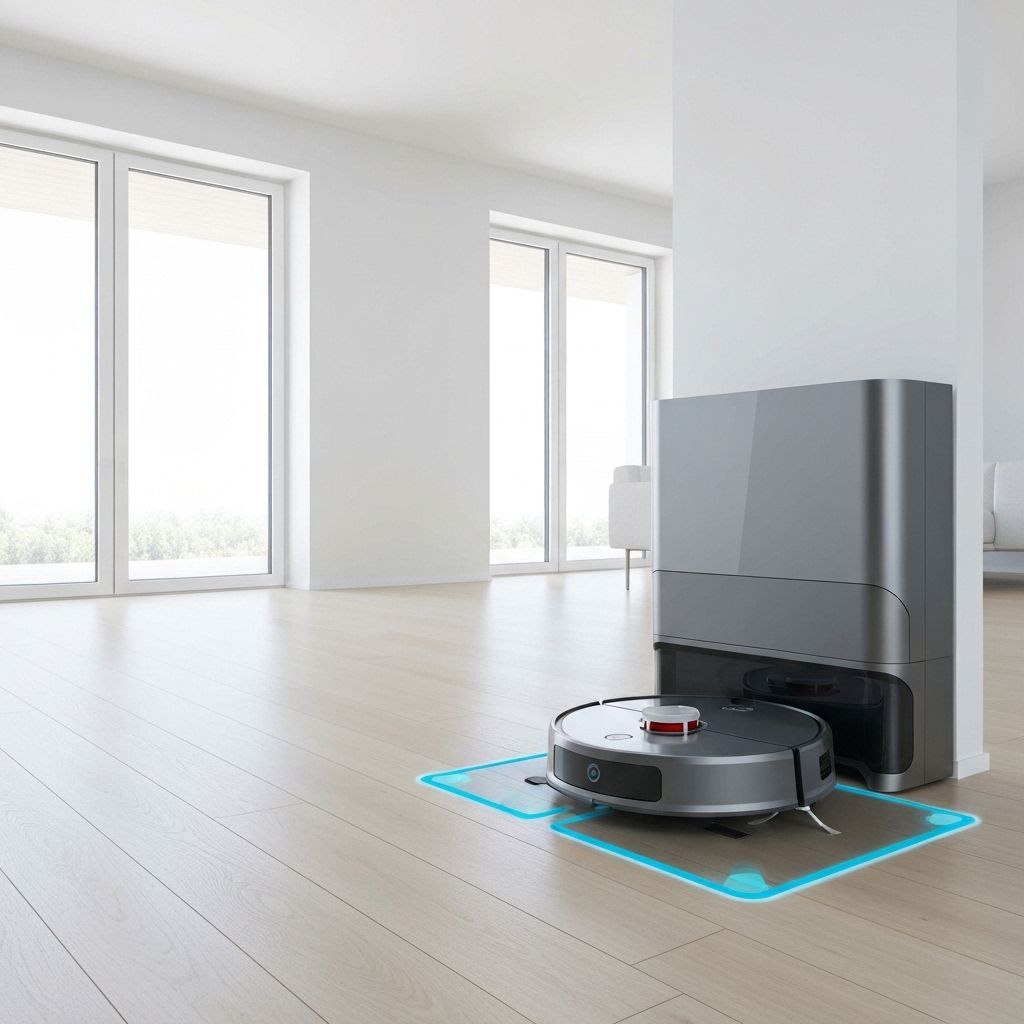Smart Robot Vacuums: The Tech-Savvy Person's Essential Home Automation
If you consider yourself tech-savvy, you understand that true intelligence isn't about having the latest gadgets—it's about automating repetitive tasks to free up time for what matters. Enter the modern robot vacuum: a sophisticated piece of autonomous robotics that represents the perfect intersection of artificial intelligence, sensor fusion, and practical home automation.
Why Tech Enthusiasts Need Robot Vacuums
It's Not About Cleaning—It's About Systems Optimization
For the technically minded, a robot vacuum isn't just a cleaning tool—it's a fascinating study in autonomous navigation, machine learning, and IoT integration. These devices employ the same fundamental technologies used in self-driving cars, warehouse automation, and Mars rovers.
The Technical Appeal:
- LiDAR Navigation: 360° laser distance scanning creating real-time 3D maps
- SLAM Algorithms: Simultaneous Localization and Mapping for intelligent path planning
- Edge Computing: Onboard processors making split-second navigation decisions
- IoT Integration: Wi-Fi connectivity enabling remote control and smart home integration
- Machine Learning: Adaptive algorithms that improve cleaning efficiency over time
The Vyzzle E20: Technical Deep Dive
The Vyzzle Navigation Hands-Free Cleaning E20 represents excellent value in the robot vacuum market, incorporating advanced navigation technology typically found in premium models.
👉 Get the Vyzzle E20 Robot Vacuum on Amazon UK
Navigation Technology: The Brain of the Operation
LiDAR-Based Mapping System
The E20 employs Light Detection and Ranging (LiDAR) technology—the same principle used in autonomous vehicles and surveying equipment. Here's how it works:
- Laser Emission: A rotating laser emits pulses at 360° around the device
- Time-of-Flight Calculation: Measures the time for laser pulses to bounce back from obstacles
- Distance Mapping: Calculates precise distances to create a detailed room map
- Real-Time Processing: Updates the map continuously as it navigates
This results in cleaning patterns that are 95% more efficient than random-bounce navigation systems found in budget models.
SLAM Algorithm Implementation
Simultaneous Localization and Mapping (SLAM) is the computational challenge of building a map while simultaneously tracking the robot's location within that map. The E20's SLAM implementation includes:
- Probabilistic Mapping: Uses Bayesian inference to handle sensor uncertainty
- Loop Closure Detection: Recognizes when it returns to previously mapped areas
- Dynamic Obstacle Avoidance: Adapts to moving objects (pets, people)
- Multi-Floor Memory: Stores separate maps for different levels of your home
Sensor Fusion: Multiple Data Streams for Intelligent Navigation
The E20 doesn't rely solely on LiDAR. It employs sensor fusion—combining data from multiple sensors for robust navigation:
- Cliff Sensors: Infrared sensors detect stairs and drops to prevent falls
- Bump Sensors: Mechanical sensors detect physical contact with obstacles
- Wheel Encoders: Track wheel rotations for precise odometry
- Gyroscope: Measures angular velocity for accurate turning
- Accelerometer: Detects movement and orientation changes
This multi-sensor approach provides redundancy—if one sensor fails or provides ambiguous data, others compensate.
Suction and Cleaning Technology
Variable Suction Power
The E20 features adjustable suction power (typically 2000-4000 Pa), which it can modulate based on:
- Surface Type Detection: Increases power on carpets, reduces on hard floors
- Dirt Detection: Optical sensors identify heavily soiled areas
- Battery Conservation: Reduces power in clean areas to extend runtime
Brush System Engineering
- Main Roller Brush: Counter-rotating bristles agitate carpet fibers
- Side Brushes: Sweep debris from edges and corners into the suction path
- Anti-Tangle Design: Prevents hair wrap-around (crucial for pet owners)
Smart Home Integration: The IoT Ecosystem
Wi-Fi Connectivity and App Control
The E20 connects to your home network (2.4GHz Wi-Fi) enabling:
- Remote Operation: Start, stop, or schedule cleaning from anywhere
- Real-Time Mapping: View cleaning progress and coverage maps
- Zone Management: Define no-go zones, specific cleaning areas, or room priorities
- Cleaning History: Track cleaning sessions, coverage area, and time spent
Voice Assistant Integration
Compatible with Amazon Alexa and Google Assistant for voice control:
- "Alexa, ask robot vacuum to clean the kitchen"
- "Hey Google, send the vacuum to its charging dock"
- "Alexa, what's the vacuum's battery level?"
Home Automation Scenarios
For the truly tech-savvy, integrate your robot vacuum into broader automation routines:
- Departure Routine: When your smart lock detects you've left, trigger a cleaning cycle
- Scheduled Cleaning: Clean specific rooms on specific days (kitchen daily, bedrooms weekly)
- Sensor Triggers: If air quality sensors detect dust, initiate cleaning
- Notification Integration: Receive push notifications when cleaning completes or errors occur
Battery Technology and Power Management
Lithium-Ion Battery System
Modern robot vacuums use high-capacity lithium-ion batteries (typically 2600-5200 mAh) with sophisticated power management:
- Runtime: 90-120 minutes on standard mode
- Recharge Time: 3-4 hours for full charge
- Auto-Recharge: Returns to dock when battery drops below 20%
- Resume Cleaning: After recharging, returns to where it left off
Intelligent Power Allocation
The E20's firmware includes algorithms that optimize battery usage:
- Path Efficiency: Calculates optimal cleaning routes to minimize travel distance
- Dynamic Power Adjustment: Reduces suction on hard floors to conserve energy
- Battery Health Monitoring: Tracks charge cycles and estimates remaining battery life
Why Tech-Savvy People Love Robot Vacuums
1. Automation Philosophy
Tech enthusiasts understand the value of automation. Every hour spent manually vacuuming is an hour not spent coding, gaming, creating, or learning. Robot vacuums embody the "automate the mundane" philosophy that drives technological progress.
2. Data and Analytics
Modern robot vacuums generate fascinating data:
- Coverage Maps: Visualize cleaning patterns and efficiency
- Time Tracking: See how long different rooms take to clean
- Maintenance Alerts: Predictive notifications for filter changes and brush cleaning
- Historical Trends: Track cleaning frequency and coverage over time
For data nerds, this is endlessly fascinating.
3. Continuous Improvement
Many robot vacuums receive firmware updates that improve performance:
- Navigation Improvements: Better obstacle avoidance algorithms
- New Features: Additional cleaning modes or smart home integrations
- Bug Fixes: Resolving edge cases in navigation or mapping
It's like having a device that gets better over time—the opposite of planned obsolescence.
4. Hackability and Customization
For the truly adventurous, robot vacuums can be modified:
- Custom Firmware: Some models support open-source firmware (Valetudo for Roborock)
- API Access: Integrate with custom home automation systems
- Sensor Additions: Add cameras or additional sensors for enhanced capabilities
Comparing Robot Vacuum Technologies
Navigation Systems Comparison
Random Navigation (Budget Models)
- Pros: Cheap, simple
- Cons: Inefficient, misses spots, takes 3x longer
- Coverage: 60-70%
Gyroscope Navigation (Mid-Range)
- Pros: Better than random, affordable
- Cons: No room mapping, can get confused
- Coverage: 75-85%
Camera-Based Navigation (Mid-High Range)
- Pros: Visual mapping, object recognition
- Cons: Struggles in low light, privacy concerns
- Coverage: 85-90%
LiDAR Navigation (High-End, including E20)
- Pros: Precise mapping, works in darkness, highly efficient
- Cons: Slightly more expensive
- Coverage: 95-98%
Suction Power Comparison
- 1000-1500 Pa: Basic cleaning, hard floors only
- 2000-2500 Pa: Good for most homes, light carpets
- 3000-4000 Pa: Excellent for carpets and pet hair (E20 range)
- 5000+ Pa: Premium models, deep carpet cleaning
Technical Considerations Before Buying
Network Requirements
- Wi-Fi Band: Most require 2.4GHz (not 5GHz)
- Router Compatibility: Ensure your router supports IoT devices
- Network Security: Consider VLAN isolation for IoT devices
Home Layout Factors
- Floor Transitions: Can it handle thresholds between rooms?
- Carpet Types: High-pile carpets may challenge some models
- Furniture Clearance: Measure under-furniture height (most need 10cm)
- Cable Management: Loose cables can tangle brushes
Maintenance Requirements
Robot vacuums require regular maintenance:
- Dustbin Emptying: Every 1-3 cleaning sessions
- Filter Cleaning: Weekly rinse, monthly replacement
- Brush Cleaning: Remove tangled hair weekly
- Sensor Cleaning: Wipe sensors monthly for optimal performance
- Wheel Maintenance: Check for debris in wheel assemblies
Advanced Features to Look For
Mopping Capability
Some models (including many in the E20's price range) include mopping:
- Water Tank: Controlled water dispensing
- Mop Pad: Microfiber pad for wet cleaning
- Carpet Detection: Automatically lifts mop on carpets
Self-Emptying Docks
Premium models feature auto-empty stations:
- Automatic Dustbin Emptying: Transfers debris to larger dock container
- Capacity: Holds 30-60 days of debris
- HEPA Filtration: Traps allergens during emptying
Object Recognition
AI-powered models can identify and avoid:
- Pet waste (crucial for pet owners)
- Cables and cords
- Shoes and small objects
- Pet food bowls
The ROI Calculation for Tech Enthusiasts
Time Savings
- Manual vacuuming: 30-60 minutes per session
- Frequency: 2-3 times per week
- Annual time saved: 52-156 hours
- Value at £20/hour: £1,040-£3,120 annually
Cost Analysis
- Initial investment: £200-£600
- Annual maintenance: £30-£50 (filters, brushes)
- Electricity cost: £10-£15 annually
- Payback period: 3-6 months based on time value
Integration with Smart Home Ecosystems
Home Assistant Integration
For advanced users running Home Assistant:
- Create custom automations
- Integrate with presence detection
- Combine with other smart home devices
- Access detailed cleaning statistics
IFTTT Recipes
Use If This Then That for creative automations:
- "If weather forecast shows high pollen, run vacuum at 6 AM"
- "If calendar shows 'party' event, clean house 2 hours before"
- "If smart doorbell detects package delivery, pause vacuum"
Why the Vyzzle E20 is Perfect for Tech Enthusiasts
- Advanced Navigation: LiDAR technology typically found in £500+ models
- Smart Home Ready: Full Wi-Fi and voice assistant integration
- Excellent Value: Premium features at mid-range pricing
- Reliable Performance: Consistent cleaning with minimal intervention
- Future-Proof: Firmware updates and expandable ecosystem
👉 Get the Vyzzle E20 Robot Vacuum on Amazon UK
Gift Presentation Ideas for Robot Vacuums
- Tech Setup Service: Offer to configure the app and smart home integration
- Cleaning Schedule: Pre-program an optimal cleaning schedule
- Accessory Bundle: Include extra filters and brushes
- Smart Home Integration: Set up voice commands and automations
- Name the Robot: Create a fun certificate with a robot name


